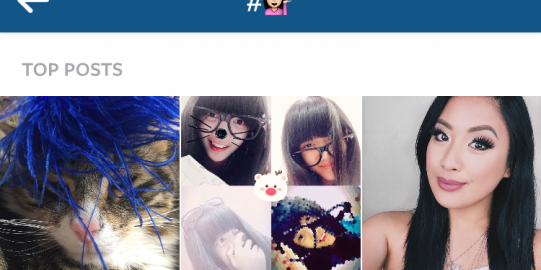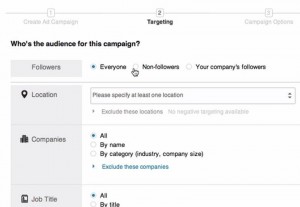
Social media is all about connecting, building relationships, and networking. Unfortunately, the art of networking correctly through social media is one that’s learned through experience. If you’re handling your brand’s social media success, or simply building your personal brand, avoid these sins. Otherwise, you’ll face the wrath of your followers.
1. Thou Shalt Be Mindful of What You Post
What you post on your profiles is a direct reflection of who you are. What do your online profiles say about you? Are they filled with stories you’d rather leave buried, or do you come off as a respected professional?
Your social profiles are part of your personal brand and they show how you want to be perceived both personally and professionally. Before you post anything, stop and think: What message does this convey to people?
Justine Sacco, the former Senior Director of Corporate Communications at IAC, sent one insensitive tweet that was meant to be a joke. Instead, it cost Sacco her job. This could’ve been avoided had she considered the damage a tweet like this could do to her reputation.

You need to be aware of what you’re putting out there. Unfortunately, anything you post on social media can come back to bite you later. Take Kathryn Knott, for example. Kathryn was accused of being involved in a hate crime, and her Twitter account went viral. And not in a good way. Her tweets presented her to the world as the bigoted, spoiled daughter of a local police officer. The tweets and negative attention even got her fired.
If you want to avoid backlash like this, do searches on yourself to see how you rank online. Do you like what comes up? It’s okay if you don’t. Here are some ways to fix your search results:
- Clean Up Your Social Media Profiles. Remove photos and content that isn’t in line with your personal brand.
- Build Your Online Persona. Start cultivating a brand that lines up with your goals. If you want to get involved in a certain industry, make it known online. Share industry posts on social media, especially the accounts you use professionally.
- Make Profiles Private. If you’re worried about your private posts, make all personal profiles private and enable settings to control who views your social profiles. However, it’s important to note this isn’t the best option for professional networking.
- Be Mindful of What You Post. It’s not always possible to make your profiles private. So if you’re using them for both personal and professional networking, you must be careful what you post. You may think something is funny, but it could offend someone else. Think before you post to avoid retractions or hurting the feelings of your readers.
- Keep an Eye on Your Online Reputation. Watch where you’re tagged online. You can use tools like Talkwalker, Mention, and BrandYourself to help monitor what people say about you online. Pro Tip: There are settings on Facebook that make it possible to approve or deny any tags before they show up on your profile. (Unfortunately, the post will still exist on your friend’s profile. But you won’t be tagged.)
2. Thou Shalt Update
An updated profile is a happy profile. It takes work to keep your profiles up-to-date but the payoff can be great. “Laziness can infect all social media outlets,” says Ed McMasters of the Flottman Company, “The more you put into it, the more you get out of it.”
On LinkedIn, you show off your skills without the limitations of a conventional resume. Highlighting classes, seminars, and volunteer experiences showcase yourself as a well-rounded person to get to know. People seek other people with similar experiences and hobbies, so keeping an up-to-date profile and an engaging demeanor will help grow your ‘social’ circle.
In addition to updating your profile, it should be complete. Where you went to school and where you work are important, but so are highlighting accomplishments, milestones, or even published work. As Matthew Books of American Car Craft says, “Nothing says ‘I’m unprofessional,’ like an incomplete profile.”
On all social media platforms, it’s important to post relevant, thought-provoking content. Katie Bisson, the Marketing & PR Manager at Technology Seed, says, “If you want anyone to interact with your brand it’s important to post a mixture of content and sales pitches. Case studies, blogs, etc. allow for you to get your message to me socially more than just hard selling. Also, content tends to have a higher engagement rate than just a sales pitch.”
3. Thou Shalt be Picky with Recommendations and Endorsements
Don’t give out LinkedIn recommendations willy nilly. You should only recommend someone if you know their quality of work. If you wouldn’t be impressed by their work, don’t recommend them on LinkedIn.
You shouldn’t accept every recommendation, either. Recommendations show the world what you excel at, so only accept the most appropriate ones. Friends should never recommend you on LinkedIn unless you have worked together professionally as well. Recommendations from superiors or vendors you’ve worked with directly will help you be taken more seriously.
LinkedIn endorsements are just as important, if not more important, than recommendations. They show off what makes you a superstar in your career. If you’re an account manager for a digital marketing agency, clients want to see that you’ve been endorsed for skills like customer service and account management.
And it’s not only who endorses you that matters, but who you endorse. Only endorse contacts for the skills you’ve seen them use. The best practice is to never endorse people you’ve never worked with directly.
4. Thou Shalt Be Honest
Speaking of endorsements, remember that honesty is the best policy. Don’t post a fake recommendation and endorsements on your friend’s profiles, or ask them to do the same for you. You’ll both look bad when the truth comes out. This simple act of boasting could cost you your job, or worse, that of someone else.
Again, your online persona is a reflection of who you are. Do you want to be seen as a liar?
5. Thou Shalt Not Use Automated DM’s
“Thanks for the follow! If you want to continue the conversation do X, Y, and Z.”

We’ve all seen it: that annoying message you get after following someone on Twitter. It looks like they’re trying to build a real relationship with you, until you read their messages.
Clearly, these are auto-generated responses. If they were really looking to forge a relationship, the DM would be catered to me. This lack of real ‘social’ media simply makes hitting unfollow that much more gratifying.
Photographer, Richard Storm, agrees. “Auto DMs are basically clickbait. We just met; I don’t care about you yet.” He continues, “It’s such an impersonal message in anyone’s inbox: ‘Thanks for connecting. I can’t wait to see what you share. Can you take a minute and blah blah blah love me.’”
Instead of automating direct messages, send your new followers individual tweets. Yes, it can be time consuming. But a personalized tweet is far more impactful than your impersonal DM. People like receiving your undivided attention, even if it’s just for a moment.
6. Thou Shalt Not Use Facebook for Networking
Facebook is for your friends.
Facebook isn’t typically a platform where you’ll go out of your way to add new people. Reserve Facebook for people you actually know. This is the medium where we share the most personal information. Therefore, it’s best to leave strangers off of it.
While there are industries that benefit from Facebook networking, it’s important to understand that most people use the social network for personal connections only. That’s why you shouldn’t be offended if your friend request is denied by someone you wish to connect with for business. Instead, follow the brand that person represents. That way, you’ll be able to consume the brand’s content, and attempt to build a relationship with the brand rather than just the person.
7. Thou Shalt Learn the Art of the Hashtag
Hashtags get yourself, or your brand, involved in online conversations. In fact, many companies have branded hashtags to fuel engagement with their communities and Twitter chats evolved as a way to further continue conversations.
Pro Tip:If you want to be involved in a Twitter chat or conversation, make sure your profile is set to public. If you are set to private, only your followers will see what you post using the hashtag. This won’t help if you’re responding to a user that doesn’t follow you. (The same goes for Instagram.)
Unfortunately, the hashtag also seems to be one of the most misunderstood aspects of social media. Some basic rules for using a hashtag are:
- Avoid Symbols. You may think the hashtag #mommy/daughter is a really cute idea for your Instagram photo. Unfortunately, only the “mommy” portion of your tag will work. Symbols break up your hashtag, and your content won’t be included in the intended conversation.

- Avoid Emoji. While Instagram hashtags can currently support emoji, they aren’t compatible with hashtags on other sites. If you plan on posting the same message on multiple platforms, avoid using them in your tags, or remove this portion of your message before posting elsewhere.

- Don’t Use More than Three. Too many hashtags is a desperate cry for attention. We get it, you want people to see your picture. But this isn’t the way to do it. Frankly, using too many hashtags is annoying to your followers.
- Keep It Short and Sweet. Hashtagging a long phrase isn’t going to include you in any conversation. Hashtags should be concise, no more than one to three words. As much as I love Kim Zolciak-Biermann, she’s guilty of this. If you clicked these hashtags, you’d notice her tweets are the only ones in the conversation.

- Know When to Use Them. Twitter’s unique algorithm will pull keywords from your tweet to have them appear in specific streams, so there is no need to hashtag a keyword. For example, the tweet: “Here’s a great post about the 10 Commandments of Networking on Social Media” doesn’t need to have #Networking or #SocialMedia to reach those audiences. Use that valuable space to tag some networks, like #Twitter or #LinkedIn.
Before you use a hashtag, check it out first. Don’t be one of the many PR nightmares that could’ve been avoided by double-checking a hashtag first. Here’s some tips for safeguarding your hashtags:
- Check the Language. Make sure there are no alternative meanings to your tag. The #SusanAlbumParty tweets should speak for themselves.
- Is It in Line with Your Brand? No brand wants to be associated with controversy. DiGiorno’s #WhyIStayed tweet was meant to be funny, but it wound up offending victims of domestic violence.
- Don’t Hijack a Tag Inappropriately. Know what’s going on within the conversation before you use it. Spirit Airlines failed to do their due-diligence when they used the hashtag #BareFares to promote their low prices. The hashtag #BareFares was used in reaction to a leak of private celebrity photos, not a low airfare. Their insensitivity left a lot of empty seats as a result.
- Make Sure It Hasn’t Been Used Before. If it has, use your judgement. CelebBoutique learned this lesson the hard way when promoting a Kardashian-inspired ‘Aurora’ dress the day of the Aurora, Colorado shooting.
8. Thou Shalt Check Your Links
Do they work?
I prefer tweets with shortened links. It’s just something I think looks cleaner and takes up less character space. Hootsuite and Bitly allow you to shorten links to truncate the amount of space a URL takes up on a social post. But before you tweet your shorter link, make sure it still works and goes to where you intend it to go. Otherwise you could see some embarrassing results.
9. Thou Shalt Not Spam Groups
Nobody likes the guy that shows up at a party and only talks about himself. So don’t be that guy in LinkedIn groups.
These groups are for the sharing of ideas and to generate a conversation with like-minded individuals. Communication, collaboration, and the sharing of ideas gains favor with other members of the group. Once you’ve established yourself, post articles sparingly to spark discussions and gain awareness.
You’re not going to take the advice of someone you only just met, right? No! They have to prove the value of what they say. That’s why you can’t expect people to eat up your gospel if you won’t eat it yourself.
10. Thou Shalt Not Post Selfies on LinkedIn
Selfies belong on Instagram, not LinkedIn. LinkedIn is a social network meant to showcase your professional talents, not your new haircut. Instead, use LinkedIn to share articles or express topics that pique your professional interests. It gets the conversation going with your network, and that pays off much more than a ‘like’ on your selfie. It could even open up professional opportunities for you!
The bottom line is, you need to put the ‘social’ in social media. If you want to make quality connections online, follow these guidelines. Then thou shalt have tons of quality contacts.
(193)







